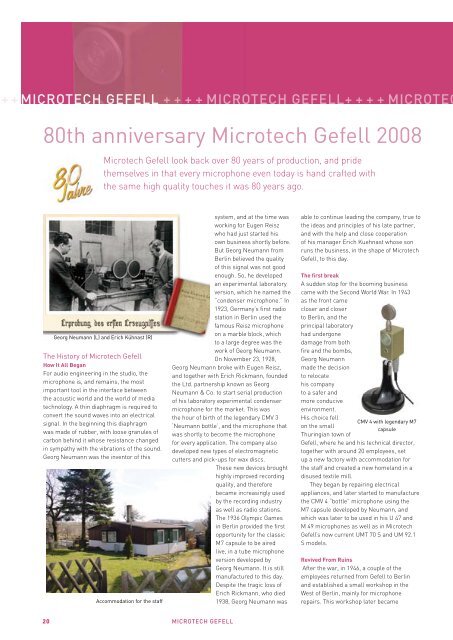microphones 2008-AUDIO+ + + + M-AUDIO+ + + + M-AUDIO+ + + + M-AUDIO+ + + + M-AUDM-<strong>Audio</strong> then ages the capsuleartificially using a multi-stageprocess to give it maximumstability for a lifetime of use. As aresult of this confluence, Sputnik’ssound incorporates the best ofthe Neumann and AKG traditionswhile forging its own distinctive,musical character. Some expertsfeel it even compares to therevered ELAM-251.“The Sputnik soundsabsolutely wonderful in everysituation,” says Grammynominatedproducer PatrickLeonard. “The Sputnik seems tofall somewhere between [classicNeumann and AKG] mics –smooth, clean and dynamic withexcellent range. It’s nice to finda microphone that sounds clean and purewithout severely colouring the signal oneway or another. And very few microphoneshave such an elegant EQ response. Becauseof the way they’re constructed, the Sputnikmicrophones are much more closelymatched than a pair of vintage U47s.”In bringing the Sputnik to market,M-<strong>Audio</strong> engineers committed to designingand manufacturing a microphone of thehighest caliber. From the hand-selectedU.S. military-grade vacuum tube, toGerman-made Wima capacitors, to thecustom-wound two-bobbin nickel-alloyoutput matching transformer – every detailwas thoroughly scrutinised internally at testbenches, as well as by a host of top LosAngeles recording engineers in listeningtests. The result is a recording microphonefor those who appreciate classicsensibilities while demanding accurate andtrue sound.Testing In Real-World SituationsProviding practical solutions for workingmusicians involves intense real world testing– but not just when the design is complete.M-<strong>Audio</strong> solicits input from top Los Angelesmusic producers and engineers throughoutthe development process. The companycollects real-world feedback throughevaluation sessions at Hollywood scoringstages and professional recording studios.By the time each M-<strong>Audio</strong> microphone isreleased to the public, it has already beenscrutinised by an elite group of professionalmix engineers and producers.Pulsar II boxed matched pair set – an ideal solution forprecision stereo recordings of orchestras, piano, choir,acoustic guitar, and drum overheads.M-<strong>Audio</strong> Pulsar II – An InstrumentMicrophone Par ExcellenceThe Pulsar II small-diaphragmtransformerless condenser is a premiuminstrument microphone that’s available asboth a single unit and as a boxed matchedpair. Key to the success of the Pulsar II isits superb off-axis response – an extremelyimportant consideration in applicationsfor this mic. For orchestral recordings,as well as drum-overhead recordings,the sound of the recording room and theinteraction between the instruments andrecording space is probably as importantas the direct sound the microphonecaptures. Accordingly, M-<strong>Audio</strong> spentconsiderable time refining the capsule andgrille structures of the Pulsar II to ensure anatural off-axis response for capturing thesound of recording spaces.Continuing The LegacyM-<strong>Audio</strong> has a comprehensive studiocondenser line – which includes theaward-winning Nova, Luna, and Solarismicrophones, in addition to the Sputnikand Pulsar II detailed here. Available inlimited quantities, M-<strong>Audio</strong> microphonesare a rare breed fusing the best qualities ofclassic soul, modern technology, state-ofthe-artmanufacturing, and hand assembly.Rather than merely attempting to emulatethe great microphones of the past,M-<strong>Audio</strong> recording instruments build onthose legacies to bring unique new creativeoptions that are welcome additions to eventhe most sophisticated microphone locker.Choose the ideal M-<strong>Audio</strong> microphonefor every application.CONTACT DETAILSM-<strong>Audio</strong> USA, 5795 Martin Rd., Irwindale, CA91706 USAt +1 (626) 633-9050f +1 (626) 633-9070e info@m-audio.comw ww.m-audio.comM-<strong>Audio</strong> UK, Floor 6, Gresham House, 53Clarendon Road, Watford WD17 1LA, UnitedKingdomt +44 (0)1923 204010f +44 (0)1923 204039e info@maudio.co.ukw ww.maudio.co.ukTHE INTERNATIONAL MICROPHONE BUYER’S GUIDE 19
++microtech gefell + + + + microtech gefell+ + + + microtec80th anniversary Microtech Gefell 2008Microtech Gefell look back over 80 years of production, and pridethemselves in that every microphone even today is hand crafted withthe same high quality touches it was 80 years ago.Georg Neumann (L) and Erich Kühnast (R)The History of Microtech GefellHow It All BeganFor audio engineering in the studio, themicrophone is, and remains, the mostimportant tool in the interface betweenthe acoustic world and the world of mediatechnology. A thin diaphragm is required toconvert the sound waves into an electricalsignal. In the beginning this diaphragmwas made of rubber, with loose granules ofcarbon behind it whose resistance changedin sympathy with the vibrations of the sound.Georg Neumann was the inventor of thisAccommodation for the staffsystem, and at the time wasworking for Eugen Reiszwho had just started hisown business shortly before.But Georg Neumann fromBerlin believed the qualityof this signal was not goodenough. So, he developedan experimental laboratoryversion, which he named the“condenser microphone.” In1923, Germany’s first radiostation in Berlin used thefamous Reisz microphoneon a marble block, whichto a large degree was thework of Georg Neumann.On November 23, 1928,Georg Neumann broke with Eugen Reisz,and together with Erich Rickmann, foundedthe Ltd. partnership known as GeorgNeumann & Co. to start serial productionof his laboratory experimental condensermicrophone for the market. This wasthe hour of birth of the legendary CMV 3‘Neumann bottle’, and the microphone thatwas shortly to become the microphonefor every application. The company alsodeveloped new types of electromagneticcutters and pick-ups for wax discs.These new devices broughthighly improved recordingquality, and thereforebecame increasingly usedby the recording industryas well as radio stations.The 1936 Olympic Gamesin Berlin provided the firstopportunity for the classicM7 capsule to be airedlive, in a tube microphoneversion developed byGeorg Neumann. It is stillmanufactured to this day.Despite the tragic loss ofErich Rickmann, who died1938, Georg Neumann wasable to continue leading the company, true tothe ideas and principles of his late partner,and with the help and close cooperationof his manager Erich Kuehnast whose sonruns the business, in the shape of MicrotechGefell, to this day.The first breakA sudden stop for the booming businesscame with the Second World War. In 1943as the front camecloser and closerto Berlin, and theprincipal laboratoryhad undergonedamage from bothfire and the bombs,Georg Neumannmade the decisionto relocatehis companyto a safer andmore conduciveenvironment.His choice fellon the smallThuringian town ofCMV 4 with legendary M7capsuleGefell, where he and his technical director,together with around 20 employees, setup a new factory with accommodation forthe staff and created a new homeland in adisused textile mill.They began by repairing electricalappliances, and later started to manufacturethe CMV 4 “bottle” microphone using theM7 capsule developed by Neumann, andwhich was later to be used in his U 47 andM 49 microphones as well as in MicrotechGefell’s now current UMT 70 S and UM 92.1S models.Revived From RuinsAfter the war, in 1946, a couple of theemployees returned from Gefell to Berlinand established a small workshop in theWest of Berlin, mainly for microphonerepairs. This workshop later became20 microtech gefell















